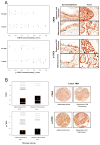Cyclic AMP response element-binding protein overexpression: a feature associated with negative prognosis in never smokers with non-small cell lung cancer
- PMID: 18676828
- PMCID: PMC3058903
- DOI: 10.1158/0008-5472.CAN-07-5376
Cyclic AMP response element-binding protein overexpression: a feature associated with negative prognosis in never smokers with non-small cell lung cancer
Abstract
Lung cancer is the leading cause of cancer deaths worldwide. Recent advances in targeted therapies hold promise for the development of new treatments for certain subsets of cancer patients by targeting specific signaling molecule. Based on the identification of the transcription factor cyclic AMP response element-binding protein (CREB) as an important regulator of growth of several types of cancers and our recent findings of its importance in normal differentiation of bronchial epithelial cells, we hypothesized that CREB plays an important pathobiologic role in lung carcinogenesis. We conducted this initial study to determine whether the expression and activation status of CREB are altered in non-small cell lung cancer (NSCLC) and of any prognostic importance in NSCLC patients. We found that the expression levels of mRNA and protein of CREB and phosphorylated CREB (p-CREB) were significantly higher in most of the NSCLC cell lines and tumor specimens than in the normal human tracheobronchial epithelial cells and adjacent normal lung tissue, respectively. Analysis of CREB mRNA expression and the CREB gene copy number showed that CREB overexpression occurred mainly at the transcriptional level. Immunohistochemical analysis of tissue microarray slides containing sections of NSCLC specimens obtained from 310 patients showed that a decreased survival duration was significantly associated with overexpression of CREB or p-CREB in never smokers but not in current or former smokers with NSCLC. These are the first reported results illustrating the potential of CREB as a molecular target for the prevention and treatment of NSCLC, especially in never smokers.
Figures




References
-
- Kamath AV, Chhajed PN. Role of bronchoscopy in early diagnosis of lung cancer. Indian J Chest Dis Allied Sci. 2006;48:265–9. - PubMed
-
- Jemal A, Siegel R, Ward E, et al. Cancer statistics, 2008. CA Cancer J Clin. 2008;58:71–96. - PubMed
-
- Broker LE, Giaccone G. The role of new agents in the treatment of non-small cell lung cancer. Eur J Cancer. 2002;38:2347–61. - PubMed
-
- Paez JG, Janne PA, Lee JC, et al. EGFR mutations in lung cancer: correlation with clinical response to gefitinib therapy. Science (New York, NY) 2004;304:1497–500. - PubMed
-
- Lynch TJ, Bell DW, Sordella R, et al. Activating mutations in the epidermal growth factor receptor underlying responsiveness of non-small-cell lung cancer to gefitinib. The New England journal of medicine. 2004;350:2129–39. - PubMed
Publication types
MeSH terms
Substances
Grants and funding
LinkOut - more resources
Full Text Sources
Other Literature Sources
Medical

